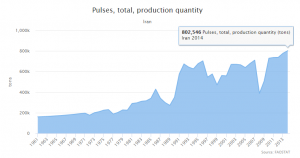Beans and peas (legumes) are a great nutrition value, a good source of protein, and have a significant role in Iranians’ diet, since there are so many traditional dishes containing different types of pulses- kidney beans, lentils, chick peas and split peas being the most popular ones. Pinto beans and mung beans are becoming more prevalent day by day.
Considering the whole legumes production in Iran is about 800 thousand tons a year, Lorestan province is the biggest producer with a yearly production of about 130 thousand tons. Iran is 90% self-sufficient in legumes production and imports the remaining 10%. Eastern-Azerbaijan is the biggest supplier of split peas in Iran and producces 95% of the country’s demand. Fars and Kermanshah provinces are standing in third and fourth place.
Pulses Import to Iran
Self-sufficiency in wheat production has led to enourmous import of other products such as legumes. According to the Ministry of Agriculture in the year 2015-2016 Iran imported about 40 thousand tons of beans in 2015.

Chick peas and lentils are the top two products of Iran. Chick peas accounts for 40% of total legumes production in Iran, beans for 34% and lentils for almost 20%.
Iran pulses consumption per capita
As pulses are great substitute for meat, they could make for a more considerable part of daily diet. Iranians consume less than 10 kg (per capita) of pulses yearly. According to the WHO, the recommended yearly intake of pulses averages 50 kilograms per capita, making Iranians falling short of the recommended average. This holds such importance that the FAO named 2016 the year of pulses to invite countries to focus their health programs on pulses and legumes.
Iran Weather and Pulses cultivation
Farmers across the highlands of Iran who rely on chickpeas production face a number of constraints during the cold winter months, including extreme cold, fungi, and weed infestation. Yields suffer and many opt instead to plant in the spring and avoid crop failure.
In collaboration with Iran’s Agricultural Research Education and Extension Organization (AREEO), ICARDA has released a new variety of high-yielding winter chickpeas, which is tolerant of cold temperatures and resistant to ascochytablight(fungi). The variety – named ‘Saral’ – is being disseminated to farmers across the highland regions of west and north-west Iran.
In trials over the past twelve years, Saral has achieved a mean yield of 1350 kg/hectare – a 25 percent increase over local varieties. Coupled with integrated pest management practices, the variety could be a game-changer for farmers – promising higher and more stable yields, and greater incomes. Adoption would also improve water productivity – helping to achieve ‘more crop per drop’ – and enhance soil health.
Soil erosion in Iran
Soil erosion in Iran is so high that it is costing the country $56 billion every year. On average, soil erosion in Iran is three times more than other Asian countries, and it is one of the highest in the world
However, water (consumption) is also the second challenge in Iran. Instead of 40 percent, Iranians are draining over 80 percent of their water reservoirs, the result of which is water stress across the country. Water-level has been declining in more than 60 main plains in the center of Iran. Besides, the fastest desertification of the century has taken place in Lake Urmia where 480,000 hectares of the land have turned into desert within 15 years.
Instead of investing in soil and water, Iranians could move towards high-tech and alternative energies and take advantage of 4,700 kilometers of their maritime border or historical Silk Road.
Agriculture accounts for over 90 per cent of water use in Iran. The government’s policies on food self-sufficiency and agricultural development have contributed to the high water consumption rates of the industry. According to Iranian Ecologist, Mohammad Darvish, this process has led to drastic shortages in water.
Challenges of Production in Iran
Even though the government helps and supports the agricultural sector to improve and become self-sufficient, the production of pulses and legumes are experiencing some difficulties. The main reasons are:
-
As discussed earlier, Iran is facing drought and the country is encountering many difficulties in providing water resources. Rainfed agriculture could be an alternative, but because of a climate change-induced rainfall deficit in different areas the quality of products has remained low.
-
Lack of scientific agriculture and management doesn’t allow distributors to count on an assured amount of product which leads to a tendency toward importing pulses from international markets such as Brazil, Argentine, India, Canada, Australia, Ethiopia etc.
-
An undeniable difference in price is not easily condoned. As a result of the aforementioned challenges, the fixed price of produced pulses has increased by almost 50% percent.
-
The packaging industry is underdeveloped in Iran. So to have products with competitive quality, Iranian producers would have to increase the end-user price so significantly that it would no longer be commercially viable.

Dear
We need to import chickpeas to Pakistan and need price ex factory
Thanks